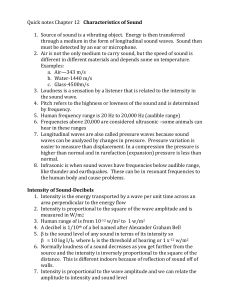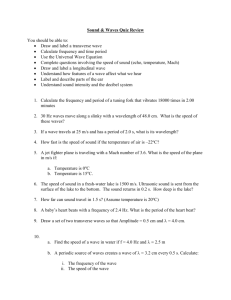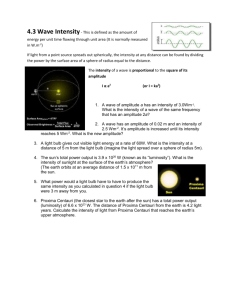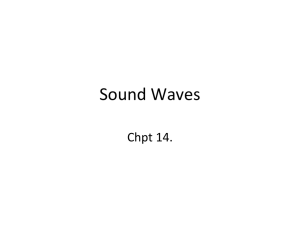basics-of-sound
advertisement
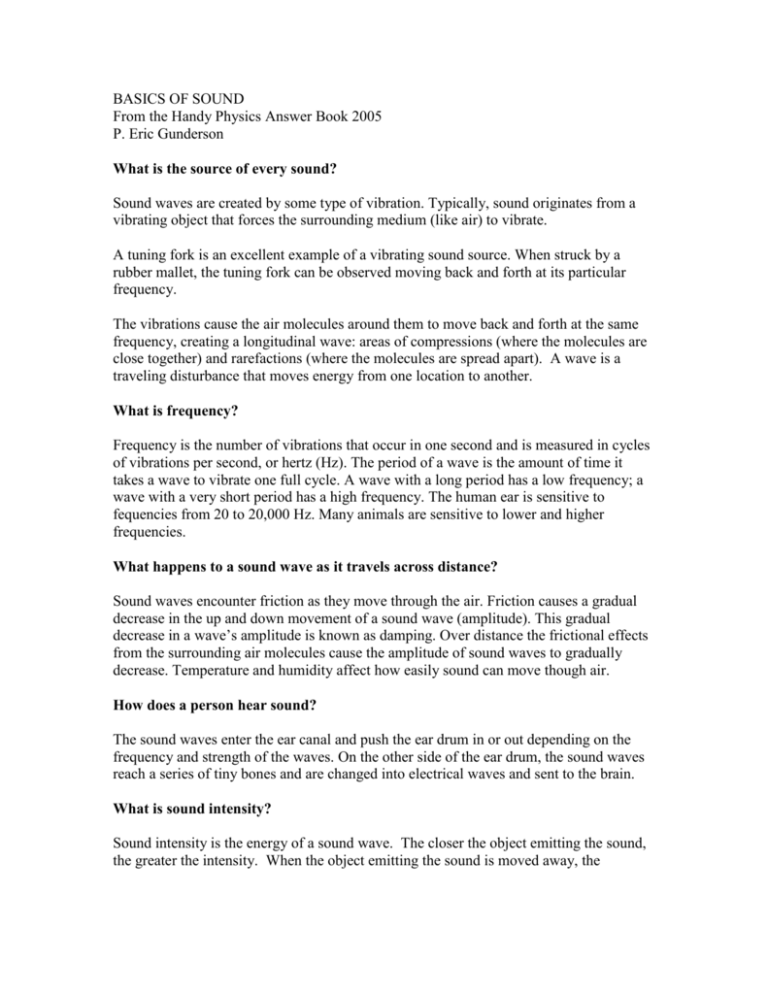
BASICS OF SOUND From the Handy Physics Answer Book 2005 P. Eric Gunderson What is the source of every sound? Sound waves are created by some type of vibration. Typically, sound originates from a vibrating object that forces the surrounding medium (like air) to vibrate. A tuning fork is an excellent example of a vibrating sound source. When struck by a rubber mallet, the tuning fork can be observed moving back and forth at its particular frequency. The vibrations cause the air molecules around them to move back and forth at the same frequency, creating a longitudinal wave: areas of compressions (where the molecules are close together) and rarefactions (where the molecules are spread apart). A wave is a traveling disturbance that moves energy from one location to another. What is frequency? Frequency is the number of vibrations that occur in one second and is measured in cycles of vibrations per second, or hertz (Hz). The period of a wave is the amount of time it takes a wave to vibrate one full cycle. A wave with a long period has a low frequency; a wave with a very short period has a high frequency. The human ear is sensitive to fequencies from 20 to 20,000 Hz. Many animals are sensitive to lower and higher frequencies. What happens to a sound wave as it travels across distance? Sound waves encounter friction as they move through the air. Friction causes a gradual decrease in the up and down movement of a sound wave (amplitude). This gradual decrease in a wave’s amplitude is known as damping. Over distance the frictional effects from the surrounding air molecules cause the amplitude of sound waves to gradually decrease. Temperature and humidity affect how easily sound can move though air. How does a person hear sound? The sound waves enter the ear canal and push the ear drum in or out depending on the frequency and strength of the waves. On the other side of the ear drum, the sound waves reach a series of tiny bones and are changed into electrical waves and sent to the brain. What is sound intensity? Sound intensity is the energy of a sound wave. The closer the object emitting the sound, the greater the intensity. When the object emitting the sound is moved away, the intensity decreases. The temperature, humidity, and wind direction of the air the sound moves through can have an affect on this as well. Why does sound diminish as we are further away from its source? The amplitude of the sound wave is damped by friction in its travel though air. Also, sound waves do not travel in a narrow path, but spread out in the air in a spherical form. The amount of energy in the emitted sound is fixed, so the energy per unit area decreases as the area increases. How much it decreases can be affected by the quality of the air it is moving though. How much is a sound’s intensity diminished by distance? The intensity of sound is inversely proportional to the square of the distance. In other words, if a person stands 1,000 feet away from a source of sound, the sound intensity might be called an arbitrary unit of 1,000. If the same person moved so that he was 2,000 feet away from the speaker, the intensity would be one over the square of the change in distance, or 1/4 the intensity. If the listener moved 3,000 feet away, the intensity would be 1/9 the intensity it was at the 1,000 mark. Once again, the temperature and humidity and wind speed in the air may change this, allowing the intensity of sound waves to travel farther or not as far, but there will always be some diminishing by distance. What is a decibel? A decibel (abbreviated dB) is the internationally adopted unit for the relative intensity of sound. The intensity is “relative” because the measurement compares a loudness level to a reference level, usually the threshold of human hearing. The decibel scale is a logarithmic scale, meaning that for every 10 decibels, the loudness of a sound is increased by a factor of 10. For example, a relative intensity change of 30 dB to 40 dB means the sound will be ten times more intense than it was at 30 dB. A change of 30 dB to 50 dBs would mean the sound would be 100 times as intense. A sound level of 30 dB is pretty quiet: it’s what a whisper may register at a distance of 4 meters (16 feet). A quiet night in the country may be 25 dB or even lower; in the bedroom it may be only 20 dB. A normal conversation produces noise around 60 dB. A blender in the kitchen can register at 80 dB. A lawn mower may have an intensity of 90 dB to the person operating it. A busy urban environment may be around 75 dB. A rock concert can hit 110 dB. The human ear also responds to noise in a logarithmic way. Every increase of 10 dB, which is a tenfold increase in the noise intensity, is perceived as a doubling of the sound level. Why is noise pollution dangerous? In the past, noise pollution was only thought to create health effects if the intensity was large enough to cause hearing damage. However, studies over the past several decades have found that long-term exposure to noise can cause potentially severe health problems in addition to hearing loss, especially for young children. Constant levels of noise (even at low levels) can be enough to cause stress, which can lead to high blood pressure, insomnia, and psychiatric problems, and can even impact memory and thinking skills in children. In a German study, scientists found that children living near the Munich Airport had higher levels of stress, which impaired their ability to learn, while children living further away from the airport did not seem to experience the same problem. Low-frequency noise, near and below what the ear can detect, is also recognized as a serious threat to health, causing cardiovascular problems, dizziness, migraines, distraction, and tinnitus in some people. What limits have been established to reduce exposure to noise pollution? The World Health Organization has recommended that noise during sleep should be limited to a level of 35 dB, and governments are beginning to place restrictions on noise levels in both residential and business environments.
